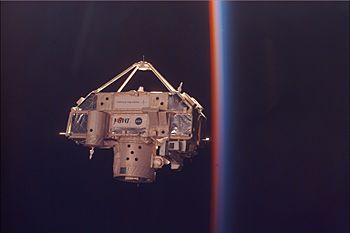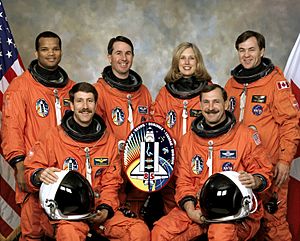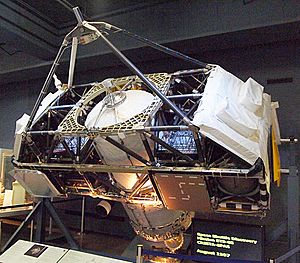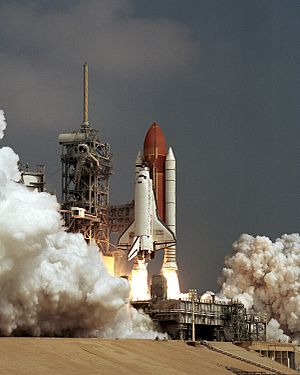STS-85 facts for kids

The CRISTA-SPAS experiment in its ninth and final day of free flight in proximity to Discovery
|
|
| Mission type | Research |
|---|---|
| Operator | NASA |
| Mission duration | 11 days, 20 hours, 28 minutes, 7 seconds |
| Distance travelled | 7,600,000 kilometres (4,700,000 mi) |
| Orbits completed | 185 |
| Spacecraft properties | |
| Spacecraft | Space Shuttle Discovery |
| Payload mass | 9,191 kilograms (20,263 lb) |
| Crew | |
| Crew size | 6 |
| Members |
|
| Start of mission | |
| Launch date | 7 August 1997, 14:41 UTC |
| Launch site | Kennedy LC-39A |
| End of mission | |
| Landing date | 19 August 1997, 11:08 UTC |
| Landing site | Kennedy SLF Runway 33 |
| Orbital parameters | |
| Reference system | Geocentric |
| Regime | Low Earth |
| Perigee | 249 kilometres (155 mi) |
| Apogee | 261 kilometres (162 mi) |
| Inclination | 57.0 degrees |
| Period | 89.6 minutes |
  Left to right – Seated: Rominger, Brown; Standing: Curbeam, Robinson, Davis, Tryggvason |
|
STS-85 was a special Space Shuttle mission using the orbiter Discovery. It launched from the Kennedy Space Center in Florida on August 7, 1997. The main goal of this mission was to carry out many different science experiments in space.
A very important part of the mission was deploying the CRISTA-SPAS free-flying satellite. This satellite had several telescopes on board to study Earth's atmosphere.
Contents
Meet the STS-85 Crew
The STS-85 mission had a crew of six brave astronauts. Each person had a very important job to do.
| Position | Astronaut | |
|---|---|---|
| Commander | Curtis L. Brown, Jr. Fourth spaceflight |
|
| Pilot | Kent V. Rominger Third spaceflight |
|
| Mission Specialist 1 | N. Jan Davis Third and last spaceflight |
|
| Mission Specialist 2 | Robert L. Curbeam, Jr. First spaceflight |
|
| Mission Specialist 3 | Stephen K. Robinson First spaceflight |
|
| Payload Specialist 1 | Bjarni V. Tryggvason, CSA Only spaceflight |
|
| Jeffrey Ashby was first chosen to be the pilot for this mission. However, he needed to step down due to a family situation. Kent Rominger took his place as pilot. | ||
What Did the Crew Do?
- Commander Curtis L. Brown, Jr. was in charge of the entire mission. This was his fourth trip to space.
- Pilot Kent V. Rominger helped fly the Space Shuttle. This was his third space flight.
- Mission Specialist N. Jan Davis was a key scientist and operator. She used the Shuttle's robotic arm.
- Mission Specialist Robert L. Curbeam, Jr. was on his first space mission.
- Mission Specialist Stephen K. Robinson also made his first journey into space.
- Payload Specialist Bjarni V. Tryggvason was from the Canadian Space Agency. He focused on specific experiments. This was his only space flight.
Mission Highlights and Experiments
The STS-85 mission was NASA's sixth Space Shuttle flight in 1997. A major part of the mission involved deploying and retrieving a special satellite. This satellite was designed to study Earth's middle atmosphere. The mission also tested new equipment for the future International Space Station.
CRISTA-SPAS Satellite
The main experiment was the Cryogenic Infrared Spectrometers and Telescopes for the Atmosphere-Shuttle Pallet Satellite-2 (CRISTA-SPAS-2). This was its second trip on a Space Shuttle. It was a joint project between the German Space Agency (DARA) and NASA.
During the flight, astronaut Jan Davis used Discovery's robotic arm. She carefully deployed the CRISTA-SPAS satellite. It then flew freely in space for about nine days. CRISTA-SPAS had three telescopes and four special instruments called spectrometers. These tools measured different gases and how the middle part of Earth's atmosphere moves. Jan Davis later used the robotic arm again to bring the satellite back to Discovery.
The Shuttle Pallet Satellite (SPAS) is like a self-contained platform. It holds the science instruments and provides power. It also allows communication with Discovery while it flies on its own.
Other Atmosphere Studies
Two other instruments on the SPAS platform also studied Earth's atmosphere:
- Middle Atmosphere High Resolution Spectrograph Instrument (MAHRSI): This instrument measured chemicals like hydroxyl and nitric oxide. It did this by sensing ultraviolet (UV) light given off or reflected by the atmosphere.
- Surface Effects Sample Monitor (SESAM): This was a passive carrier for special optical surfaces. It helped scientists study how atomic oxygen and the space environment affect materials.
Robotic Arm Test for Space Station
The crew also supported an experiment called the Manipulator Flight Demonstration (MFD). This experiment was sponsored by NASDA, the Japanese Space Agency. The MFD had three separate parts located in Discovery's cargo bay. Its main goal was to test a new, very flexible robotic arm in space. This test was important before installing the arm on the Japanese Experiment Module (JEM) of the International Space Station.
Other Experiments on Board
Several other experiments, called Hitchhiker payloads, were also in Discovery's cargo bay. These included:
- The Technology Applications and Science Payload (TAS-01).
- The International Extreme Ultraviolet Hitchhiker (IEH-02).
- The Ultraviolet Spectrograph Telescope for Astronomical Research (UVSTAR).
These experiments worked on their own, without needing much help from the crew.
Microgravity Vibration Isolation Mount (MIM)
Canadian Space Agency astronaut Bjarni Tryggvason operated the Microgravity Vibration Isolation Mount (MIM) experiment. MIM is a small device, about the size of two lockers. It was designed to protect experiments on the International Space Station from vibrations. These vibrations can come from things like rocket thrusters firing or astronauts moving around. The MIM experiment ran for 30 hours, sending data back to scientists on Earth.
Observing Comet Hale-Bopp
Another experiment on STS-85 was the Southwest Ultraviolet Imaging System (SWUIS-01). This system was a wide-field UV imager. It was used to observe the famous Comet Hale-Bopp. SWUIS used an 18-centimeter Maksutov UV telescope and a special UV-sensitive camera. This camera could take many images very quickly.
The SWUIS was set up inside the Shuttle's mid-deck cockpit. It looked out through a special quartz window. The mission specialists set up and operated this instrument.
Fun Fact and Mission Extension
On the eighth day of the mission, the crew woke up to a special song. It was "You Will Go to the Moon" by the Canadian band Moxy Früvous. Astronaut Marc Garneau, the first Canadian in space, chose this song.
The mission lasted one day longer than planned. This was because of a threat of ground fog at the Kennedy Space Center. The fog could have made landing unsafe.



